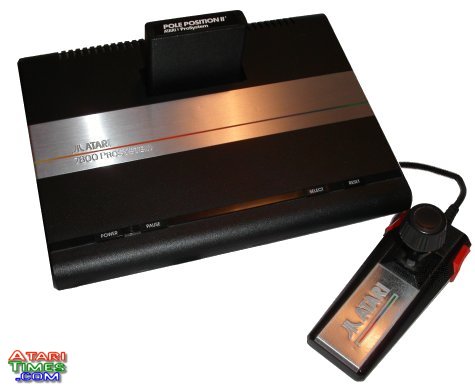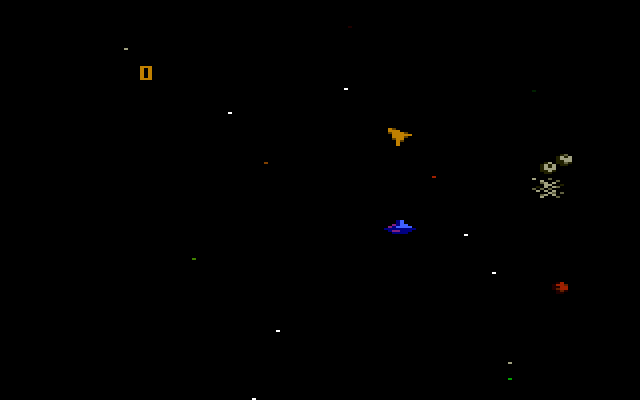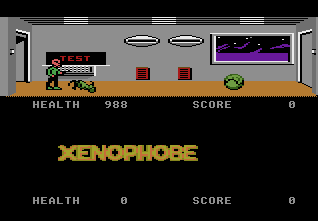 |
 |
The Atari 7800: Doomed Twice? |
 Over the years, almost everyone has blamed the death of the Atari 7800 on the Tramiels for canning it prior to its summer 1984 release, and waiting until 1986 to debut the machine. Some have even went as far as saying the death of the 7800 meant the death of Atari. However, even the original 1984 plan for the 7800 was fundamentally
flawed. The 7800's postponement until 1986 insured the machine's death, but it is likely the7800 would have failed anyway under the guidance of Warner's Atari Inc.
Over the years, almost everyone has blamed the death of the Atari 7800 on the Tramiels for canning it prior to its summer 1984 release, and waiting until 1986 to debut the machine. Some have even went as far as saying the death of the 7800 meant the death of Atari. However, even the original 1984 plan for the 7800 was fundamentally
flawed. The 7800's postponement until 1986 insured the machine's death, but it is likely the7800 would have failed anyway under the guidance of Warner's Atari Inc.
Atari's Flawed 7800 Plan
Flash back to 1984 - a company losing over a million dollars a day and its primary market - video games and consoles - in
shambles. Atari's last hope - an amazing new gaming console dubbed the 7800.This machine sported almost unlimited potential for creating arcade gaming experiences at
home! Never before seen was power like this in a home game console! And a whole new line of software to...
...wait a second ...what new software?
Once again Atari Inc. was making the same mistake they did with the 5200.There were no new games for this machine. Okay - maybe a couple, but aside from Desert Falcon, which was merely Zaxxon with a bird, none of the new games for this machine were a leap forward from existing games. What Atari Inc. had to offer in 1984 was old, albeit good, arcade translations. But they were the same games that contributed to the flop of the 5200.
 Remember, the failure of the 5200 wasn't because of the crumby controllers (were Colecovision's controllers that much better?), nor was it a lack of
marketing: it was a lack of innovative, new software. Games such as
Donkey Kong, the Smurf series, Zaxxon, and Buck Rogers introduced the home gamer to a new world of
entertainment. Atari was pushing games that were impressive translations, but they were older games that no longer captured the imagination of the gaming public.The Atari 2600 beat Mattel because, by comparison, Intellivision games were boring -
conversely, most of the 5200's games were dull when compared to the Colecovision.
Remember, the failure of the 5200 wasn't because of the crumby controllers (were Colecovision's controllers that much better?), nor was it a lack of
marketing: it was a lack of innovative, new software. Games such as
Donkey Kong, the Smurf series, Zaxxon, and Buck Rogers introduced the home gamer to a new world of
entertainment. Atari was pushing games that were impressive translations, but they were older games that no longer captured the imagination of the gaming public.The Atari 2600 beat Mattel because, by comparison, Intellivision games were boring -
conversely, most of the 5200's games were dull when compared to the Colecovision.
 So why would Atari expect consumers to rush out and buy yet another console that didn't
offer anything new? Backward compatibility would only be a reason for new consumers-if you already had a 2600 you could already play 2600 games. There were not any planned "must-have games" for the 7800.Nor was the planned pack-in game a
reason. Is
Pole Position II really that much better than Pole Position for the 2600 or 5200?Certainly it is a great port, but it wasn't offering new gameplay that consumers needed to see to open their wallets.
So why would Atari expect consumers to rush out and buy yet another console that didn't
offer anything new? Backward compatibility would only be a reason for new consumers-if you already had a 2600 you could already play 2600 games. There were not any planned "must-have games" for the 7800.Nor was the planned pack-in game a
reason. Is
Pole Position II really that much better than Pole Position for the 2600 or 5200?Certainly it is a great port, but it wasn't offering new gameplay that consumers needed to see to open their wallets.
 Atari, in many ways, was doing to the 7800 what they did to the 5200:the machine could
have very likely rung the death bell for the company. Sure they had planned a few things right - a high-score cartridge and compatibility with 2600 controllers (except where right/left fire is required), but many of their other plans were
flawed. Has a computer add-on ever propelled sales of a video game machine? The only somewhat popular computer add-on, the Coleco Adam, was considered crap by the computing public, and at $140 for the 7800 console alone, a C64 or Atari 600XL or 800XL would have been a much wiser purchase for those looking for a computer.
Atari, in many ways, was doing to the 7800 what they did to the 5200:the machine could
have very likely rung the death bell for the company. Sure they had planned a few things right - a high-score cartridge and compatibility with 2600 controllers (except where right/left fire is required), but many of their other plans were
flawed. Has a computer add-on ever propelled sales of a video game machine? The only somewhat popular computer add-on, the Coleco Adam, was considered crap by the computing public, and at $140 for the 7800 console alone, a C64 or Atari 600XL or 800XL would have been a much wiser purchase for those looking for a computer.
The resurgence of video games in 1985/1986 was not due to Nintendo's "amazing" new hardware - it was due to an amazing new game: Super Mario Bros. Here was a pack-in game that offered what was never before seen in home video games -- a cute side-scrolling adventure that appealed to almost everybody young and old! Once Super Mario caught on, the tide simply shifted Nintendo's way.
 Perhaps if Jack Tramiel had not entered the scene, and Atari Inc. introduced the 7800 with a pack-in game such as Namco's
Pac-Land (which the 7800 would be capable of accurately recreating with a POKEY chip onboard the cart), there might have been
hope. At the time, Atari
had strong links to Namco, and maybe Atari would have fought back with
something like this in 1986 to counteract Nintendo...one will never know. But as introduced with games such as
Galaga and Pole Position -- the 7800 just didn't cut it. At best, the machine would have only been a moderate success, and Atari
itself may have not lasted until 1986 to understand from Nintendo's model what consumers really wanted.
Perhaps if Jack Tramiel had not entered the scene, and Atari Inc. introduced the 7800 with a pack-in game such as Namco's
Pac-Land (which the 7800 would be capable of accurately recreating with a POKEY chip onboard the cart), there might have been
hope. At the time, Atari
had strong links to Namco, and maybe Atari would have fought back with
something like this in 1986 to counteract Nintendo...one will never know. But as introduced with games such as
Galaga and Pole Position -- the 7800 just didn't cut it. At best, the machine would have only been a moderate success, and Atari
itself may have not lasted until 1986 to understand from Nintendo's model what consumers really wanted.
Enter Jack Tramiel - Exit 7800
The 7800 was canned the moment Jack Tramiel took the reins of Atari.
Yes, Jack Tramiel canned the 7800 for the wrong reasons- not because of the previously discussed flawed plan for its release, but a desire to focus strictly on
computers. However, the entire situation of Warner's Atari Inc. has to be looked at to understand what the Tramiels were doing.
Jack Tramiel took over a company losing a million dollars a day, a company that nobody (especially Warner) wanted, and a company that was losing market-share and consumer
confidence. Look back to the business press of 1984.They were very unfavorable towards Atari, even with the looming 7800.They didn't become bullish on Atari until Tramiel shifted the company's focus to home
computers. Atari needed an entirely new vision to survive, and the 7800 just didn't offer that.
1986 - 7800 Born Again!
Jack Tramiel's Atari Corporation chose to release the 7800 in 1986 after seeing the revival of the video game market headed up by
Nintendo. At this point, Atari's corporate focus was computers, not video games.
The company was ill-prepared for this debut, and by this point Nintendo owned the home market.
Of course, every armchair quarterback is wiser in hindsight and can offer a thousand opinions as to how Atari could have returned to number one. However, it would have been nearly impossible for Atari to successfully compete in this market. Back in 1985 and early 1986, with Atari out of the picture as a viable video game company, Nintendo easily secured exclusivity contracts with game manufacturers and practiced other monopolistic techniques. (To discuss these practices in detail would require another article entirely, so I am going to avoid any deep analysis of the specifics of Nintendo's policies and just examine Atari Corporation's efforts).
The biggest problem facing Atari Corp. was software. Upon re-entry to the home video game market, Atari could not get many licenses for the 7800, and all their top in-house game programmers from the previous era were long-gone. The new games Atari did release for the 7800 in 1987 and 1988 were slow to come to market and mediocre at best (with some exceptions). In fact, serious development for the 7800 did not come to fruition until Atari moved the Atari Entertainment division to Chicago in 1989.
 The establishment of Atari Entertainment in Chicago was done far too late to save the 7800. Most 7800 titles that offered NES style
gameplay, such as
Xenophobe and Commando, did not ship until late 1989.Other competitive releases, such as
Ninja Golf, Alien Brigade, and Midnight Mutants were not shipping until 1990!To put this in a chronological perspective, the Sega Genesis was shipping for Christmas of 1989.Atari's games came to market WAY to late to save the 7800, and brass at Atari would have been aware of this after Christmas 1989.Atari silently moved all development efforts towards the Lynx by early 1990, merely completing any 7800 projects on
tap. This would explain the lack of 7800 "vaporware". Unlike the countless prototype games for the 2600, and, to a lesser extent, the 5200, the only incomplete prototype carts to have surfaced for the 7800 are
GATO., Klax, and Pit Fighter. As for GATO,
it was announced in 1986, so it was obviously canned for reasons other than the machine's demise.
The establishment of Atari Entertainment in Chicago was done far too late to save the 7800. Most 7800 titles that offered NES style
gameplay, such as
Xenophobe and Commando, did not ship until late 1989.Other competitive releases, such as
Ninja Golf, Alien Brigade, and Midnight Mutants were not shipping until 1990!To put this in a chronological perspective, the Sega Genesis was shipping for Christmas of 1989.Atari's games came to market WAY to late to save the 7800, and brass at Atari would have been aware of this after Christmas 1989.Atari silently moved all development efforts towards the Lynx by early 1990, merely completing any 7800 projects on
tap. This would explain the lack of 7800 "vaporware". Unlike the countless prototype games for the 2600, and, to a lesser extent, the 5200, the only incomplete prototype carts to have surfaced for the 7800 are
GATO., Klax, and Pit Fighter. As for GATO,
it was announced in 1986, so it was obviously canned for reasons other than the machine's demise.
 The second problem facing Atari Entertainment in Chicago was that they were spread too thin, developing games for the 2600, 7800,
XE, ST, and Lynx! That's a lot of platforms to support, especially when compared to Nintendo and Sega supporting two
each. This problem, however, was created by earlier moves by Atari.
The second problem facing Atari Entertainment in Chicago was that they were spread too thin, developing games for the 2600, 7800,
XE, ST, and Lynx! That's a lot of platforms to support, especially when compared to Nintendo and Sega supporting two
each. This problem, however, was created by earlier moves by Atari.
First, let's examine the 2600's influence on the 7800.Atari Corp's "modern" history of this goes back to 1986, when it debuted the 2600jr.Most of Atari'sgame marketing at this time was geared towards the 2600jr (The Fun Is Back! promotion), while the 7800 was all but ignored (I have read somewhere that Atari's total launch budget for the 7800 was somewhere around a paltry $50,000!).Certainly Atari's choice to market the 2600jr made them a lot of money initially, but it may have hurt them in the long run. The 7800 was still a technologically viable platform in 88 and 89.However, in the public's eye, the 2600 remained Atari's flagship game machine, tarnishing Atari's image. Had Atari in 1986 and 1987 put a majority of their promotion resources into the 7800 instead of the 2600, and phased out the 2600 hardware sometime in 1987, perhaps the 7800 would have seen more success both then and towards the end of the decade.
Atari's other mistake was the XEGS. It probably seemed like a good idea to Atari for two reasons:
1) The platform had a huge existing library of software and development still in place.
2) It was Atari's last chance to dump it's inventory of unsellable 8-bit products as its computer division focused on the ST.
The result of the XEGS was not an increase in video game sales, but further lack of focus in Atari's video game division. As a game machine it was too computer-like, and as an entry level computer it was too game machine-like. Efforts Atari put into developing and marketing this machine would have been better spent supporting the 7800 and ST.
For the most part of the latter 80's, Nintendo held 80% of the video game market, Sega had 10%, and Atari had 10%.As we know from considerable marketing effort on Sega's behalf, the NES was impossible to beat even with heavy advertising. Sega's continued strong marketing presence throughout this time, however, contributed to the success of the Genesis. Atari Entertainment, on the other hand, should have focused STRICTLY on the 7800 during this time. I doubt it would have given them more total market share, but it most definitely would have given the 7800 more visibility and made Atari more streamlined and less confusing to the consumer.
Epilogue
Fifteen years after the initial debut of the Atari 7800, it's easy to look back and see what mistakes and successes were made by
Atari. It's also fun to speculate what should have been and what could have
been. The 7800 was innovative, and had some tremendous animation abilities, but, as tough as it is for any Atarian to admit, the bottom line is that Nintendo was the company with the plan that revived the home video game industry in the latter half of the 80's, and Atari was merely an also-ran.
| Name: | |
| Subject: | |
| Comment: | |
| Check: | What is the greatest video game company of all time? (Hint: Atari.) |